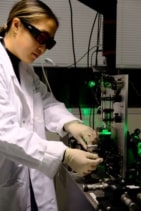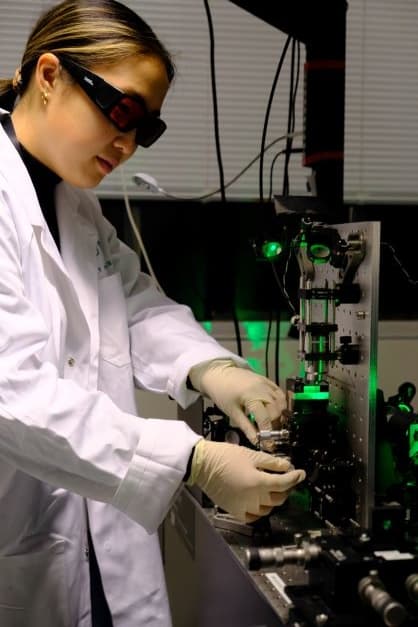
Single photons are a key foundation for many emerging quantum technologies, but creating the perfect single-photon source is challenging. This is particularly true when trying to develop compact systems that can operate outside the carefully controlled lab environment without bulky sub-zero cooling infrastructure. Scientists in Australia have now addressed this challenge by developing a new source design that can produce more than 10 million single photons per second while operating at room temperature.
A perfect single-photon source would provide the user with exactly one pure single photon on demand. Real-world devices often feature a trade-off between these ideal characteristics that varies depending on the application. In the latest work, researchers led by Igor Aharonovich of the University of Technology, Sydney based their single-photon source on a 2D crystalline material called hexagonal boron nitride (hBN). The crystal’s atomic structure is imperfect, and light from an intense source such as a laser can cause these imperfections, or defects, to emit single photons even at room temperature.
A better collection method
One of the challenges when using these materials is to develop a collection method that makes sure the generated photons are actually usable. Aharonovich and colleagues addressed this challenge by directly depositing flakes of the hBN material onto a small hemispherical collection lens, known as a solid immersion lens (SIL).

These SILs have a diameter of just 1 mm, which makes handling them a particular experimental challenge. Armed with tweezers, the researchers painstakingly placed the integrated hBN-lens into a portable custom-made microscope set-up (see image). A carefully positioned laser source then excites the sample and the SIL focuses the emitted single photons onto a detector. By combining the 2D material with a lens, the researchers demonstrated a six-fold improvement in photon collection efficiency compared to previous methods. These other methods also rely on complex nanoscale engineering processes, which makes them less suitable to mass-scale everyday quantum communication applications.
The researchers went on to demonstrate that the single photons they produce are of an excellent purity. Purity here refers to the probability of emitting a single photon rather than multiple ones – an important metric in assessing the quality of these sources. Long-term tests showed that the system generates high-purity single photons in a stable way, further confirming its suitability for deployment in applications such as quantum key distribution (QKD). In this application, better single-photon sources could improve the security of cryptography protocols used to enable the secure transmission of information without signal loss or vulnerability to eavesdroppers.
High transmission rates
Once they knew how many photons their system produces per second, the researchers estimated how effective it would be in a practical QKD scenario using a widely adopted QKD protocol known as BB84. They show that this single-photon source can maintain high transmission rates over an area around 8 km in radius, which would allow for QKD coverage on a citywide scale. Combined with the fact that the system operates at room temperature, this highlights the practicality of the system for everyday secure quantum communication applications.

Pursuing a career in science communication, commercializing single-photon detectors
Commenting on the future direction of the work, Helen Zeng, one of the researchers working on the project, states, “We are ready to turn our attention towards incorporating these quantum 2D materials into real-world applications which will undoubtedly have far-reaching consequences in the field of quantum communications.”
The new single-photon source is described in Optics Letters.
